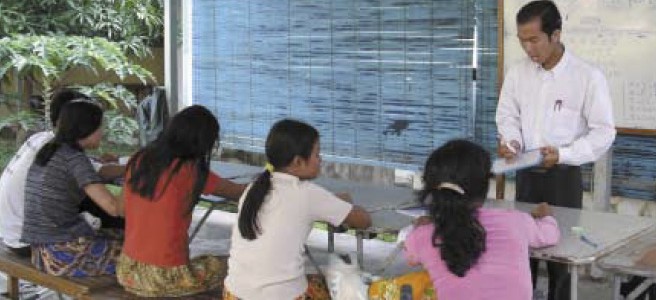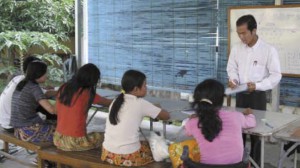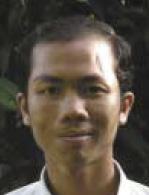
Overcoming Stigma
Originally published in the WHO Goodwill Ambassador’s Newsletter for the Elimination of Leprosy, Issue No. 23 (December 2006). The information was correct and current at the time of publication.
Once a monk with leprosy, Leng Sophea is now a happily married teacher

Leng Sophea gives a Khmer lesson to young women who have had reconstructive hand surgery.
I was born in 1984 and grew up in a poor family in Cambodia’s Kandal Province. I lived in a village with my parents Cheng Peng Leng and Youen Yenh and my two sisters and three brothers.
In 1997, I left home to go and live for one year with relatives. In 1998, I moved into a pagoda. I studied Khmer, Cambodia’s national language, for one year with a monk. I became a monk the following year, when I was 15.
In 2000, I realized that something was the matter with my health because I was developing symptoms such as a puffy face, claw-finger, drop-foot and the inability to close my eye. I found a Khmer doctor to examine me. He did not know what was wrong but he treated me with traditional medicine for one year.
I was getting better. From 2000, I also began studying the Baley language in addition to Khmer. These studies took me to Phnom Penh.
Then my condition began to take a turn for the worse. I went to another Khmer doctor who examined me and told me I needed to go to a health center.
At that point, I decided that I didn’t want to see another doctor because I didn’t have any money. Also, I was in the middle of my studies, which I loved, and I didn’t want to stop.
But my illness was progressing. My claw-hand and drop-foot were becoming worse. So I thought about it again and decided I should go and see a doctor. I didn’t know what was going to happen to me.
In 2003, a doctor in Phnom Penh told me that I had leprosy. “What is leprosy?” I asked him.
As he explained the disease, he told me that I could be cured. But he also said leprosy stigmatizes those who have it, and many people are afraid of it.
When I heard this, it made me very sad. I didn’t want to live in this world anymore. I wanted to die.
I didn’t tell my family about leprosy. I kept my condition to myself and lived alone with my worries, which were so big. I stayed in my room in the pagoda for one year. I didn’t want to go out and meet people.
“I didn’t want to live in this world any more. I wanted to die.”
Between 2003 and 2004 I was treated with MDT at a health center in Kandal Province. At the end of 2004, I had reconstructive surgery on my hands and feet.
After that, I got a job with CIOMAL at the Kien Khleang national leprosy rehabiliation unit. I now work as a Khmer language teacher and support worker. I stopped being a monk in 2005.
In July 2006, I got married to Van Tavy and have found happiness in my life.
I have had leprosy, but I will not let the disease stigmatize me. As to the future, I hope to study at university one day.
In the meantime, my message to everyone is: if you have any problem, please hurry and see a doctor or go to a health center.
 AUTHOR: Leng Sophea
AUTHOR: Leng Sophea
Leng Sophea works as a Khmer teacher and support worker at the Kien Khleang national leprosy rehabilitation unit in Cambodia.
